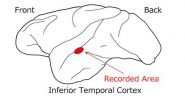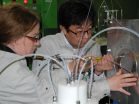(Press-News.org) TORONTO, Sept. 19, 2014 — York University researchers say a simple test that combines thinking and movement can help to detect heightened risk for developing Alzheimer's disease in a person, even before there are any telltale behavioural signs of dementia.
Faculty of Health Professor Lauren Sergio and PhD candidate Kara Hawkins who led the study asked the participants to complete four increasingly demanding visual-spatial and cognitive-motor tasks, on dual screen laptop computers. The test aimed at detecting the tendency for Alzheimer's in those who were having cognitive difficulty even though they were not showing outward signs of the disease.
"We included a task which involved moving a computer mouse in the opposite direction of a visual target on the screen, requiring the person's brain to think before and during their hand movements," says Sergio in the School of Kinesiology & Health Science. "This is where we found the most pronounced difference between those with mild cognitive impairment (MCI) and family history group and the two control groups."
Hawkins adds, "We know that really well-learned, stereotyped motor behaviours are preserved until very late in Alzheimer's disease." These include routine movements, such as walking. The disruption in communication will be evident when movements require the person to think about what it is they are trying to do.
For the test, the participants were divided into three groups – those diagnosed with MCI or had a family history of Alzheimer's disease, and two control groups, young adults and older adults, without a family history of the disease.
The study, Visuomotor Impairments in Older Adults at Increased Alzheimer's Disease Risk, published in the Journal of Alzheimer's Disease, found that 81.8 per cent of the participants that had a family history of Alzheimer's disease and those with MCI displayed difficulties on the most cognitively demanding visual motor task.
"The brain's ability to take in visual and sensory information and transform that into physical movements requires communication between the parietal area at the back of the brain and the frontal regions," explains Sergio. "The impairments observed in the participants at increased risk of Alzheimer's disease may reflect inherent brain alteration or early neuropathology, which is disrupting reciprocal brain communication between hippocampal, parietal and frontal brain regions."
"In terms of being able to categorize the low Alzheimer's disease risk and the high Alzheimer's disease risk, we were able to do that quite well using these kinematic measures," says Hawkins. "This group had slower reaction time and movement time, as well as less accuracy and precision in their movements."
Hawkins says the findings don't predict who will develop Alzheimer's disease, but they do show there is something different in the brains of most of the participants diagnosed with MCI or who had a family history of the disease.
INFORMATION:
York University is helping to shape the global thinkers and thinking that will define tomorrow. York's unwavering commitment to excellence reflects a rich diversity of perspectives and a strong sense of social responsibility that sets us apart. A York U degree empowers graduates to thrive in the world and achieve their life goals through a rigorous academic foundation balanced by real-world experiential education. As a globally recognized research centre, York is fully engaged in the critical discussions that lead to innovative solutions to the most pressing local and global social challenges. York's 11 faculties and 27 research centres are thinking bigger, broader and more globally, partnering with 288 leading universities worldwide. York's community is strong − 55,000 students, 7,000 faculty and staff, and more than 250,000 alumni.
Media Contact:
Gloria Suhasini, York University Media Relations, 416 736 2100 ext. 22094, suhasini@yorku.ca
Simple test can help detect Alzheimer's before dementia signs show: York U study
York University researchers say a simple test that combines thinking and movement can help to detect heightened risk for developing Alzheimer's disease in a person, even before there are any telltale behavioral signs of dementia.
2014-09-19
ELSE PRESS RELEASES FROM THIS DATE:
Shrink-wrapping spacesuits
2014-09-19
For future astronauts, the process of suiting up may go something like this: Instead of climbing into a conventional, bulky, gas-pressurized suit, an astronaut may don a lightweight, stretchy garment, lined with tiny, musclelike coils. She would then plug in to a spacecraft's power supply, triggering the coils to contract and essentially shrink-wrap the garment around her body.
The skintight, pressurized suit would not only support the astronaut, but would give her much more freedom to move during planetary exploration. To take the suit off, she would only have to apply ...
New hadrosaur noses into spotlight
2014-09-19
Call it the Jimmy Durante of dinosaurs – a newly discovered hadrosaur with a truly distinctive nasal profile. The new dinosaur, named Rhinorex condrupus by paleontologists from North Carolina State University and Brigham Young University, lived in what is now Utah approximately 75 million years ago during the Late Cretaceous period.
Rhinorex, which translates roughly into "King Nose," was a plant-eater and a close relative of other Cretaceous hadrosaurs like Parasaurolophus and Edmontosaurus. Hadrosaurs are usually identified by bony crests that extended from the skull, ...
Researchers discover new gene responsible for traits involved in diabetes
2014-09-19
A collaborative research team led by Medical College of Wisconsin (MCW) scientists has identified a new gene associated with fasting glucose and insulin levels in rats, mice and in humans. The findings are published in the September issue of Genetics.
Leah Solberg Woods, Ph.D., associate professor of pediatrics at MCW and a researcher in the Children's Hospital of Wisconsin Research Institute, led the study and is the corresponding author of the paper.
The authors of the paper identified a gene called Tpcn2 in which a variant was associated with fasting glucose levels ...
Don't cry wolf: Drivers fed up with slowing down at inactive roadwork sites
2014-09-19
The results of the QUT Centre for Accident Research & Road Safety - Queensland (CARRS-Q) study have been presented at the Occupational Safety in Transport Conference (OSIT) which is being held on the Gold Coast and finishes today.
Dr Ross Blackman, a CARRS-Q road safety researcher, said speed limit credibility was being put at risk when reduced speed limits and related traffic controls remained in place at inactive roadwork sites.
"It's seen as crying wolf. If people are asked to slow down at roadwork sites but find there is no roadwork being undertaken they become ...
Long-distance communication from leaves to roots
2014-09-19
Leguminous plants are able to grow well in infertile land, and bear many beans that are important to humans. The reason for this is because most legumes have a symbiotic relationship with bacteria, called rhizobia, that can fix nitrogen in the air and then supply the host plant with ammonia as a nutrient.
The plants create symbiotic organs called nodules in their roots. However, if too many root nodules are made it will adversely affect the growth of the plants, because the energy cost of maintaining excessive nodules is too large. Therefore legumes must have a mechanism ...
Lymphatic fluid used for first time to detect bovine paratuberculosis
2014-09-19
Paratuberculosis, also known as Johne's disease, is caused by the bacterium Mycobacterium avium subspecies paratuberculosis (MAP). In Austria, there is a legal obligation to report the disease. Paratuberculosis mainly affects ruminants and causes treatment-resistant diarrhoea and wasting among affected animals. The disease can cause considerable economic losses for commercial farms. The animals produce less milk, exhibit fertility problems and are more susceptible to other conditions such as udder inflammation.
To date there has been no treatment for paratuberculosis. ...
Neurons express 'gloss' using three perceptual parameters
2014-09-19
Japanese researchers showed monkeys a number of images representing various glosses and then they measured the responses of 39 neurons by using microelectrodes. They found that a specific population of neurons changed the intensities of the responses linearly according to either the contrast-of-highlight, sharpness-of-highlight, or brightness of the object. This shows that these 3 perceptual parameters are used as parameters when the brain recognizes a variety of glosses. They also found that different parameters are represented by different populations of neurons. This ...
Environmental pollutants make worms susceptible to cold
2014-09-19
Imagine you are a species which over thousands of years has adapted to the arctic cold, and then you get exposed to a substance that makes the cold dangerous for you.
This is happening to the small white worm Enchytraeus albidus, and the cold provoking substance, called nonylphenol, comes from the use of certain detergents, pesticides and cosmetics.
Nonylphenol is suspected of being a endocrine disruptor, but when entering the worm it has another dangerous effect: It inhibits the worm's ability to protect the cells in its body from cold damage.
Enchytraeus albidus ...
Quick-change materials break the silicon speed limit for computers
2014-09-19
The present size and speed limitations of computer processors and memory could be overcome by replacing silicon with 'phase-change materials' (PCMs), which are capable of reversibly switching between two structural phases with different electrical states – one crystalline and conducting and the other glassy and insulating – in billionths of a second.
Modelling and tests of PCM-based devices have shown that logic-processing operations can be performed in non-volatile memory cells using particular combinations of ultra-short voltage pulses, which is not possible with silicon-based ...
Milestone in chemical studies of superheavy elements
2014-09-19
An international collaboration led by research groups from Mainz and Darmstadt, Germany, has achieved the synthesis of a new class of chemical compounds for superheavy elements at the RIKEN Nishina Center for Accelerator-based Research (RNC) in Japan. For the first time, a chemical bond was established between a superheavy element – seaborgium (element 106) in the present study – and a carbon atom. Eighteen atoms of seaborgium were converted into seaborgium hexacarbonyl complexes, which include six carbon monoxide molecules bound to the seaborgium. Its gaseous properties ...
LAST 30 PRESS RELEASES:
New scientific resources map food components to improve human and environmental health
Mass General Brigham research identifies pitfalls and opportunities for generative artificial intelligence in patient messaging systems
Opioids during pregnancy not linked to substantially increased risk of psychiatric disorders in children
Universities and schools urged to ban alcohol industry-backed health advice
From Uber ratings to credit scores: What’s lost in a society that counts and sorts everything?
Political ‘color’ affects pollution control spending in the US
Managing meandering waterways in a changing world
Expert sounds alarm as mosquito-borne diseases becoming a global phenomenon in a warmer more populated world
Climate change is multiplying the threat caused by antimicrobial resistance
UK/German study - COVID-19 vaccine effectiveness and fewer common side-effects most important factors in whether adults choose to get vaccinated
New ultraviolet light air disinfection technology could help protect against healthcare infections and even the next pandemic
Major genetic meta-analysis reveals how antibiotic resistance in babies varies according to mode of birth, prematurity, and where they live
Q&A: How TikTok’s ‘black box’ algorithm and design shape user behavior
American Academy of Arts and Sciences elects three NYU faculty as 2024 fellows
A closed-loop drug-delivery system could improve chemotherapy
MIT scientists tune the entanglement structure in an array of qubits
Geologists discover rocks with the oldest evidence yet of Earth’s magnetic field
It’s easier now to treat opioid addiction with medication -- but use has changed little
Researchers publish final results of key clinical trial for gene therapy for sickle cell disease
Identifying proteins causally related to COVID-19, healthspan and lifespan
New study reveals how AI can enhance flexibility, efficiency for customer service centers
UT School of Natural Resources team receives grant to remove ‘forever chemicals’ from water
Sweet potato quality analysis is enhanced with hyperspectral imaging and AI
Use of acid reflux drugs linked to higher risk of migraine
For immigrants to Canada, risk of MS increases with proportion of life spent there
Targeted use of enfortumab vedotin for the treatment of advanced urothelial carcinoma
A university lecture, with a dash of jumping jacks
How light can vaporize water without the need for heat
These giant, prehistoric salmon had tusk-like teeth
New study infers our wellbeing by analyzing the language we use around ageing, using language markers to enable "a different type of access to individuals’ inner worlds"
[Press-News.org] Simple test can help detect Alzheimer's before dementia signs show: York U studyYork University researchers say a simple test that combines thinking and movement can help to detect heightened risk for developing Alzheimer's disease in a person, even before there are any telltale behavioral signs of dementia.




